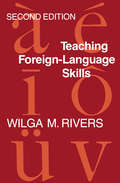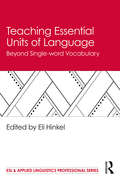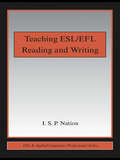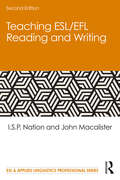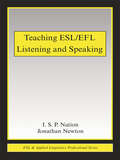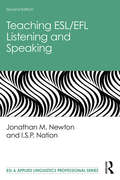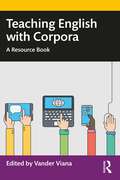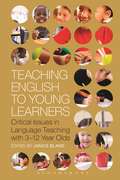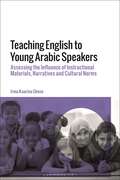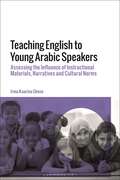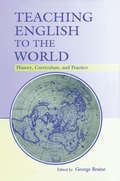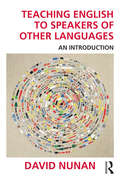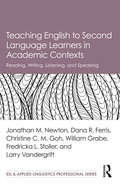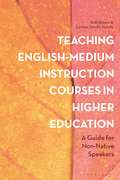- Table View
- List View
Teaching Foreign Language Skills: Second Edition
by Wilga M. RiversSince its original publication in 1968, Rivers's comprehensive and practical text has become a standard reference for both student teachers and veteran instructors. All who wish to draw from the most recent thinking in the field will welcome this new edition. Methodology is appraised, followed up by discussions on such matters as keeping students of differing abilities active, evaluating textbooks, using language labs creatively, and preparing effective exercises and drills. The author ends each chapter of this new edition with questions for research and discussion—a useful classroom tool—and provides an up-to-date bibliography that facilitates further understanding of such matters as the bilingual classroom.
Teaching Foreign Language Skills: Second Edition
by Wilga M. RiversSince its original publication in 1968, Rivers's comprehensive and practical text has become a standard reference for both student teachers and veteran instructors. All who wish to draw from the most recent thinking in the field will welcome this new edition. Methodology is appraised, followed up by discussions on such matters as keeping students of differing abilities active, evaluating textbooks, using language labs creatively, and preparing effective exercises and drills. The author ends each chapter of this new edition with questions for research and discussion—a useful classroom tool—and provides an up-to-date bibliography that facilitates further understanding of such matters as the bilingual classroom.
Teaching Essential Units of Language: Beyond Single-word Vocabulary (ESL & Applied Linguistics Professional Series)
by Eli HinkelThis textbook provides a practical and research-based foundation for teaching second language (L2) multiword units (also commonly called collocations). Multiword units – such as strong tea, beautiful weather, or would you mind –cannot be readily understood or predicted by the meanings of their component parts, and prove particularly challenging for English language learners. With contributions from top scholars, this text presents a thorough and rounded overview of the principles and practices currently dominant in teaching L2 phrases in a variety of instructional settings around the world. Divided into two sections, Part I examines the pedagogical foundations of teaching the essential units of language. Part II covers a range of techniques and classroom activities for implementing instruction. Intended for students and teacher educators, this accessible volume integrates the key principles, strategies, and applications of current and effective English language instruction for both vocabulary and grammar.
Teaching Essential Units of Language: Beyond Single-word Vocabulary (ESL & Applied Linguistics Professional Series)
by Eli HinkelThis textbook provides a practical and research-based foundation for teaching second language (L2) multiword units (also commonly called collocations). Multiword units – such as strong tea, beautiful weather, or would you mind –cannot be readily understood or predicted by the meanings of their component parts, and prove particularly challenging for English language learners. With contributions from top scholars, this text presents a thorough and rounded overview of the principles and practices currently dominant in teaching L2 phrases in a variety of instructional settings around the world. Divided into two sections, Part I examines the pedagogical foundations of teaching the essential units of language. Part II covers a range of techniques and classroom activities for implementing instruction. Intended for students and teacher educators, this accessible volume integrates the key principles, strategies, and applications of current and effective English language instruction for both vocabulary and grammar.
Teaching ESL/EFL Reading and Writing (ESL & Applied Linguistics Professional Series)
by I.S.P. NationUsing a framework based on principles of teaching and learning, this guide for teachers and teacher trainees provides a wealth of suggestions for helping learners at all levels of proficiency develop their reading and writing skills and fluency. By following these suggestions, which are organized around four strands – meaning-focused input, meaning-focused output, language-focused learning, and fluency development – teachers will be able to design and present a balanced program for their students. Teaching ESL/EFL Reading and Writing, and its companion text, Teaching ESL/EFL Listening and Speaking, are similar in format and the kinds of topics covered, but do not need to be used together. Drawing on research and theory in applied linguistics, their focus is strongly hands-on, featuring easily applied principles, a large number of useful teaching techniques, and guidelines for testing and monitoring, All Certificate, Diploma, Masters and Doctoral courses for teachers of English as a second or foreign language include a teaching methods component. The texts are designed for and have been field tested in such programs.
Teaching ESL/EFL Reading and Writing (ESL & Applied Linguistics Professional Series)
by I.S.P. NationUsing a framework based on principles of teaching and learning, this guide for teachers and teacher trainees provides a wealth of suggestions for helping learners at all levels of proficiency develop their reading and writing skills and fluency. By following these suggestions, which are organized around four strands – meaning-focused input, meaning-focused output, language-focused learning, and fluency development – teachers will be able to design and present a balanced program for their students. Teaching ESL/EFL Reading and Writing, and its companion text, Teaching ESL/EFL Listening and Speaking, are similar in format and the kinds of topics covered, but do not need to be used together. Drawing on research and theory in applied linguistics, their focus is strongly hands-on, featuring easily applied principles, a large number of useful teaching techniques, and guidelines for testing and monitoring, All Certificate, Diploma, Masters and Doctoral courses for teachers of English as a second or foreign language include a teaching methods component. The texts are designed for and have been field tested in such programs.
Teaching ESL/EFL Reading and Writing (ESL & Applied Linguistics Professional Series)
by I.S.P. Nation John MacalisterThe second edition of this bestselling text, Teaching ESL/EFL Reading and Writing, is a fully updated and expanded guide for teaching learners at all levels of proficiency how to develop their reading and writing skills and fluency. Practical and accessible, this book covers a diverse array of language teaching techniques suitable for all contexts. Updated with cutting-edge research and theory, the second edition is an essential and engaging text. Key insights and suggestions are organised around four strands – meaning-focused input, meaning-focused output, language-focused learning, and fluency development – to allow teachers to design and present a balanced programme for their students. Bringing together research and theory in applied linguistics and education, the text includes useful examples and practical strategies and features new topics related to technology, assessment, and genre. The second edition includes new tasks and further reading sections in every chapter. Teaching ESL/EFL Reading and Writing is designed for practising and pre-service teachers of all levels, and is ideal for certificate, diploma, masters, and doctoral courses in English as a second or foreign language.
Teaching ESL/EFL Reading and Writing (ESL & Applied Linguistics Professional Series)
by I.S.P. Nation John MacalisterThe second edition of this bestselling text, Teaching ESL/EFL Reading and Writing, is a fully updated and expanded guide for teaching learners at all levels of proficiency how to develop their reading and writing skills and fluency. Practical and accessible, this book covers a diverse array of language teaching techniques suitable for all contexts. Updated with cutting-edge research and theory, the second edition is an essential and engaging text. Key insights and suggestions are organised around four strands – meaning-focused input, meaning-focused output, language-focused learning, and fluency development – to allow teachers to design and present a balanced programme for their students. Bringing together research and theory in applied linguistics and education, the text includes useful examples and practical strategies and features new topics related to technology, assessment, and genre. The second edition includes new tasks and further reading sections in every chapter. Teaching ESL/EFL Reading and Writing is designed for practising and pre-service teachers of all levels, and is ideal for certificate, diploma, masters, and doctoral courses in English as a second or foreign language.
Teaching ESL/EFL Listening and Speaking (ESL & Applied Linguistics Professional Series)
by I.S.P. Nation Jonathan NewtonUsing a framework based on principles of teaching and learning, this guide for teachers and teacher trainees provides a wealth of suggestions for helping learners at all levels of proficiency develop their listening and speaking skills and fluency. By following these suggestions, which are organized around four strands – meaning-focused input, meaning-focused output, language-focused learning, and fluency development – teachers will be able to design and present a balanced program for their students. Teaching ESL/EFL Listening and Speaking, and its companion text, Teaching ESL/EFL Reading and Writing, are similar in format and the kinds of topics covered, but do not need to be used together. Drawing on research and theory in applied linguistics, their focus is strongly hands-on, featuring easily applied principles, a large number of useful teaching techniques, and guidelines for testing and monitoring. All Certificate, Diploma, Masters and Doctoral courses for teachers of English as a second or foreign language include a teaching methods component. The texts are designed for and have been field tested in such programs.
Teaching ESL/EFL Listening and Speaking (ESL & Applied Linguistics Professional Series)
by I.S.P. Nation Jonathan NewtonUsing a framework based on principles of teaching and learning, this guide for teachers and teacher trainees provides a wealth of suggestions for helping learners at all levels of proficiency develop their listening and speaking skills and fluency. By following these suggestions, which are organized around four strands – meaning-focused input, meaning-focused output, language-focused learning, and fluency development – teachers will be able to design and present a balanced program for their students. Teaching ESL/EFL Listening and Speaking, and its companion text, Teaching ESL/EFL Reading and Writing, are similar in format and the kinds of topics covered, but do not need to be used together. Drawing on research and theory in applied linguistics, their focus is strongly hands-on, featuring easily applied principles, a large number of useful teaching techniques, and guidelines for testing and monitoring. All Certificate, Diploma, Masters and Doctoral courses for teachers of English as a second or foreign language include a teaching methods component. The texts are designed for and have been field tested in such programs.
Teaching ESL/EFL Listening and Speaking (ESL & Applied Linguistics Professional Series)
by Jonathan M. Newton I.S.P. NationThis guide for teachers and teacher trainees provides a wealth of suggestions for helping learners at all levels of proficiency develop their listening and speaking skills and fluency, using a framework based on principles of teaching and learning. By following these suggestions, which are organized around four strands – meaning-focused input, meaning-focused output, language-focused learning, and fluency development – teachers will be able to design and present a balanced program for their students. Updated with cutting-edge research and theory, the Second Edition of Teaching ESL/EFL Listening and Speaking retains its hands-on focus and engaging format, and features new activities and information on emerging topics, including: Two new chapters on Extensive Listening and Teaching Using a Course Book Expanded coverage of key topics, including assessment, pronunciation, and using the internet to develop listening and speaking skills Easy-to-implement tasks and suggestions for further reading in every chapter More tools for preservice teachers and teacher trainers, such as a sample unit, a "survival syllabus," and topic prompts The second edition of this bestselling book is an essential text for all Certificate, Diploma, Masters and Doctoral courses for teachers of English as a second or foreign language.
Teaching ESL/EFL Listening and Speaking (ESL & Applied Linguistics Professional Series)
by Jonathan M. Newton I.S.P. NationThis guide for teachers and teacher trainees provides a wealth of suggestions for helping learners at all levels of proficiency develop their listening and speaking skills and fluency, using a framework based on principles of teaching and learning. By following these suggestions, which are organized around four strands – meaning-focused input, meaning-focused output, language-focused learning, and fluency development – teachers will be able to design and present a balanced program for their students. Updated with cutting-edge research and theory, the Second Edition of Teaching ESL/EFL Listening and Speaking retains its hands-on focus and engaging format, and features new activities and information on emerging topics, including: Two new chapters on Extensive Listening and Teaching Using a Course Book Expanded coverage of key topics, including assessment, pronunciation, and using the internet to develop listening and speaking skills Easy-to-implement tasks and suggestions for further reading in every chapter More tools for preservice teachers and teacher trainers, such as a sample unit, a "survival syllabus," and topic prompts The second edition of this bestselling book is an essential text for all Certificate, Diploma, Masters and Doctoral courses for teachers of English as a second or foreign language.
Teaching English with Corpora: A Resource Book
by Vander VianaTeaching English with Corpora is an accessible and practical introduction to the ways in which online and offline corpora can be used in English language teaching (ELT). Featuring 70 chapters written by an international range of researchers and practitioners, this book: • provides readers with clear, tested examples of corpus-based/driven lesson plans; • contains activities relevant to English for general purposes and English for specific purposes; • caters for the needs of English language teachers working with learners at different proficiency levels; • features flexible teaching suggestions that can be explored as part of a lesson or as a full lesson. This book is an essential purchase for pre- and in-service English language teachers as well as those studying corpus linguistics in undergraduate/Master’s courses in applied linguistics, ELT and Teaching English to Speakers of Other Languages (TESOL).
Teaching English with Corpora: A Resource Book
by Vander VianaTeaching English with Corpora is an accessible and practical introduction to the ways in which online and offline corpora can be used in English language teaching (ELT). Featuring 70 chapters written by an international range of researchers and practitioners, this book: • provides readers with clear, tested examples of corpus-based/driven lesson plans; • contains activities relevant to English for general purposes and English for specific purposes; • caters for the needs of English language teachers working with learners at different proficiency levels; • features flexible teaching suggestions that can be explored as part of a lesson or as a full lesson. This book is an essential purchase for pre- and in-service English language teachers as well as those studying corpus linguistics in undergraduate/Master’s courses in applied linguistics, ELT and Teaching English to Speakers of Other Languages (TESOL).
Teaching English to Young Learners: Critical Issues in Language Teaching with 3-12 Year Olds
by Janice BlandAimed at student teachers, educators and practitioners, Teaching English Language to Young Learners outlines and explains the crucial issues, themes and scenarios relating to this area of teaching. Each chapter by a leading international scholar offers a thorough introduction to a central theme of English as a foreign language (EFL) with preteens, with clear presentation of the theoretical background and detailed references for further reading, providing access to the most recent scholarship. Exploring the essential issues critically and in-depth, including the disadvantages as well as advantages of Teaching English as a Foreign Language (TEFL) with young learners, topics include: - task-based learning in the primary school;- storytelling;- drama;- technology;- vocabulary development;- intercultural understanding; - Content and Language Integrated Learning (CLIL) scenarios;- assessment.Innovative and rapidly emerging topics are covered, such as immersion teaching, picturebooks in the EFL classroom and English with pre-primary children.
Teaching English to Young Learners: Critical Issues in Language Teaching with 3-12 Year Olds
by Janice BlandAimed at student teachers, educators and practitioners, Teaching English Language to Young Learners outlines and explains the crucial issues, themes and scenarios relating to this area of teaching. Each chapter by a leading international scholar offers a thorough introduction to a central theme of English as a foreign language (EFL) with preteens, with clear presentation of the theoretical background and detailed references for further reading, providing access to the most recent scholarship. Exploring the essential issues critically and in-depth, including the disadvantages as well as advantages of Teaching English as a Foreign Language (TEFL) with young learners, topics include: - task-based learning in the primary school;- storytelling;- drama;- technology;- vocabulary development;- intercultural understanding; - Content and Language Integrated Learning (CLIL) scenarios;- assessment.Innovative and rapidly emerging topics are covered, such as immersion teaching, picturebooks in the EFL classroom and English with pre-primary children.
Teaching English to Young Arabic Speakers: Assessing the Influence of Instructional Materials, Narratives and Cultural Norms
by Irma-Kaarina GhosnThe book explores young Arabic-speaking children's English language learning. Through classroom-based research and learner work samples, the book analyses the interplay between cultural norms and the critical role that teachers play in orchestrating classroom discourse through skillful use of available instructional materials, questioning strategies and feedback to learners. The author shows the potential of instructional materials to influence young learners' vocabulary, reading comprehension, and written production, as well as the way they acquire the academic literacies needed in school subjects taught in English. She reviews the spread of the practice of teaching English to young and very young children and the increasing demand for English-medium instruction in the Arabic-speaking region, with a particular focus on the negative transfer from Arabic to English spelling and grammar. The book also discusses the importance of story narratives, arguing they are an ideal medium for language teaching because of their rich linguistic repertoire and the strong motivational force that stories have on young language learners and their cognitive growth, essential to their later academic success. Taken together, the research findings and classroom vignettes suggest that children's language learning happens within a complex system of interactive variables and cultural norms and expectations.
Teaching English to Young Arabic Speakers: Assessing the Influence of Instructional Materials, Narratives and Cultural Norms
by Irma-Kaarina GhosnThe book explores young Arabic-speaking children's English language learning. Through classroom-based research and learner work samples, the book analyses the interplay between cultural norms and the critical role that teachers play in orchestrating classroom discourse through skillful use of available instructional materials, questioning strategies and feedback to learners. The author shows the potential of instructional materials to influence young learners' vocabulary, reading comprehension, and written production, as well as the way they acquire the academic literacies needed in school subjects taught in English. She reviews the spread of the practice of teaching English to young and very young children and the increasing demand for English-medium instruction in the Arabic-speaking region, with a particular focus on the negative transfer from Arabic to English spelling and grammar. The book also discusses the importance of story narratives, arguing they are an ideal medium for language teaching because of their rich linguistic repertoire and the strong motivational force that stories have on young language learners and their cognitive growth, essential to their later academic success. Taken together, the research findings and classroom vignettes suggest that children's language learning happens within a complex system of interactive variables and cultural norms and expectations.
Teaching English to the World: History, Curriculum, and Practice
by George BraineTeaching English to the World: History, Curriculum, and Practice is a unique collection of English language teaching (ELT) histories, curricula, and personal narratives from non-native speaker (NNS) English teachers around the world. No other book brings such a range of international ELT professionals together to describe and narrate what they know best.The book includes chapters from Brazil, China, Germany, Hong Kong, Hungary, India, Indonesia, Israel, Japan, Lebanon, Poland, Saudi Arabia, Singapore, Sri Lanka, and Turkey. All chapters follow a consistent pattern, describing first the history of English language teaching in a particular country, then the current ELT curriculum, followed by the biography or the autobiography of an English teacher of that country. This consistency in the structuring of chapters will enable readers to assimilate the information easily while also comparing and contrasting the context of ELT in each country.The chapter authors--all born in or residents of the countries they represent and speakers of the local language or languages as well as English--provide insider perspectives on the challenges faced by local English language teachers. There is clear evidence that the majority of English teachers worldwide are nonnative speakers (NNS), and there is no doubt that many among them have been taught by indigenous teachers who themselves are nonnative speakers. This book brings the professional knowledge and experience of these teachers and the countries they represent to a mainstream Western audience including faculty, professionals, and graduate students in the field of ESL; to the international TESOL community; and to ELT teachers around the world.
Teaching English to the World: History, Curriculum, and Practice
by George BraineTeaching English to the World: History, Curriculum, and Practice is a unique collection of English language teaching (ELT) histories, curricula, and personal narratives from non-native speaker (NNS) English teachers around the world. No other book brings such a range of international ELT professionals together to describe and narrate what they know best.The book includes chapters from Brazil, China, Germany, Hong Kong, Hungary, India, Indonesia, Israel, Japan, Lebanon, Poland, Saudi Arabia, Singapore, Sri Lanka, and Turkey. All chapters follow a consistent pattern, describing first the history of English language teaching in a particular country, then the current ELT curriculum, followed by the biography or the autobiography of an English teacher of that country. This consistency in the structuring of chapters will enable readers to assimilate the information easily while also comparing and contrasting the context of ELT in each country.The chapter authors--all born in or residents of the countries they represent and speakers of the local language or languages as well as English--provide insider perspectives on the challenges faced by local English language teachers. There is clear evidence that the majority of English teachers worldwide are nonnative speakers (NNS), and there is no doubt that many among them have been taught by indigenous teachers who themselves are nonnative speakers. This book brings the professional knowledge and experience of these teachers and the countries they represent to a mainstream Western audience including faculty, professionals, and graduate students in the field of ESL; to the international TESOL community; and to ELT teachers around the world.
Teaching English to Speakers of Other Languages: An Introduction
by David NunanDavid Nunan’s dynamic learner-centered teaching style has informed and inspired countless TESOL educators around the world. In this fresh, straightforward introduction to teaching English to speakers of other languages he presents teaching techniques and procedures along with the underlying theory and principles. Complex theories and research studies are explained in a clear and comprehensible, yet non-trivial, manner without trivializing them. Practical examples of how to develop teaching materials and tasks from sound principles provide rich illustrations of theoretical constructs. The content is presented through a lively variety of different textual genres including classroom vignettes showing language teaching in action, question and answer sessions, and opportunities to ‘eavesdrop’ on small group discussions among teachers and teachers in preparation. Readers get involved through engaging, interactive pedagogical features and opportunities for reflection and personal application. Each chapter follows the same format so that readers know what to expect as they work through the text. Key terms are defined in a Glossary at the end of the book. David Nunan’s own reflections and commentaries throughout enrich the direct, up-close style of the text.
Teaching English to Speakers of Other Languages: An Introduction
by David NunanDavid Nunan’s dynamic learner-centered teaching style has informed and inspired countless TESOL educators around the world. In this fresh, straightforward introduction to teaching English to speakers of other languages he presents teaching techniques and procedures along with the underlying theory and principles. Complex theories and research studies are explained in a clear and comprehensible, yet non-trivial, manner without trivializing them. Practical examples of how to develop teaching materials and tasks from sound principles provide rich illustrations of theoretical constructs. The content is presented through a lively variety of different textual genres including classroom vignettes showing language teaching in action, question and answer sessions, and opportunities to ‘eavesdrop’ on small group discussions among teachers and teachers in preparation. Readers get involved through engaging, interactive pedagogical features and opportunities for reflection and personal application. Each chapter follows the same format so that readers know what to expect as they work through the text. Key terms are defined in a Glossary at the end of the book. David Nunan’s own reflections and commentaries throughout enrich the direct, up-close style of the text.
Teaching English to Second Language Learners in Academic Contexts: Reading, Writing, Listening, and Speaking (ESL & Applied Linguistics Professional Series)
by Jonathan M. Newton Dana R. Ferris Christine C.M. Goh William Grabe Fredricka L. Stoller Larry VandergriftTeaching English to Second Language Learners in Academic Contexts: Reading, Writing, Listening, and Speaking provides the fundamental knowledge that ESL and EFL teachers need to teach the four language skills. This foundational text, written by internationally renowned experts in the field, explains why skills-based teaching is at the heart of effective instruction in English for academic purposes (EAP) contexts. Each of the four main sections of the book helps readers understand how each skill—reading, writing, listening, and speaking—works and explains what research has to say about successful skill performance. Pedagogically focused chapters apply this information to principles for EAP curriculum design and to instructional activities and tasks adaptable in a wide range of language-learning contexts. Options for assessment and the role of digital technologies are considered for each skill, and essential information on integrated-skill instruction is provided. Moving from theory to practice, this teacher-friendly text is an essential resource for courses in TESOL programs, for in-service teacher-training seminars, and for practicing EAP teachers who want to upgrade their teaching abilities and knowledge bases.
Teaching English to Second Language Learners in Academic Contexts: Reading, Writing, Listening, and Speaking (ESL & Applied Linguistics Professional Series)
by Jonathan M. Newton Dana R. Ferris Christine C.M. Goh William Grabe Fredricka L. Stoller Larry VandergriftTeaching English to Second Language Learners in Academic Contexts: Reading, Writing, Listening, and Speaking provides the fundamental knowledge that ESL and EFL teachers need to teach the four language skills. This foundational text, written by internationally renowned experts in the field, explains why skills-based teaching is at the heart of effective instruction in English for academic purposes (EAP) contexts. Each of the four main sections of the book helps readers understand how each skill—reading, writing, listening, and speaking—works and explains what research has to say about successful skill performance. Pedagogically focused chapters apply this information to principles for EAP curriculum design and to instructional activities and tasks adaptable in a wide range of language-learning contexts. Options for assessment and the role of digital technologies are considered for each skill, and essential information on integrated-skill instruction is provided. Moving from theory to practice, this teacher-friendly text is an essential resource for courses in TESOL programs, for in-service teacher-training seminars, and for practicing EAP teachers who want to upgrade their teaching abilities and knowledge bases.
Teaching English-Medium Instruction Courses in Higher Education: A Guide for Non-Native Speakers
by Ruth Breeze Carmen Sancho GuindaThis book provides practical help and guidance for non-native English-speaking higher education lecturers faced with the need to deliver lectures and seminars in English. It builds on the authors' years of experience as researchers and teacher trainers in the area of English Medium Instruction (EMI), combining practical advice and research findings with useful case studies from different global settings, including Australia, China, Hong Kong, Slovakia, Spain, the UK and the USA, and a range of subject areas, such as philosophy, mathematics and genetics. The authors present an overview of what generally happens when university teachers make the transition to teaching in English. After dispelling some common myths and setting out priorities, Ruth Breeze and Carmen Sancho Guinda move on to explain how practitioners can prepare to give lectures and interact with both local and international students effectively in English, tackling difficult issues, such as encouraging participation, promoting creativity and critical thinking, and evaluating written student work. The final chapters address good practices in EMI, proposing ways to achieve excellence in global settings.
